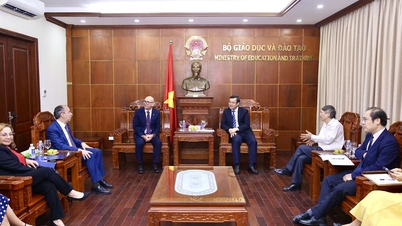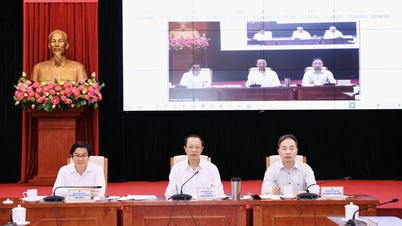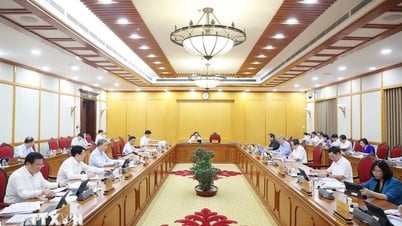In recent times, the Law on HigherEducation has basically met the practical requirements of higher education development, bringing about many remarkable results. However, in the process of implementation, many limitations and shortcomings still need to be resolved.
University autonomy is a correct policy.
After 5 years of implementation (2019-2023), the Law on Higher Education has basically met the practical requirements of higher education development, enhanced the effectiveness and efficiency of state management of higher education, enhanced the autonomy of higher education institutions, ensured international integration, better met the human resource training needs of the socialist-oriented market economy , contributed to the development of education and training, improved the intellectual level and quality of human resources, trained talents for the country and contributed to the socio-economic development of the country.
Implementing the autonomy mechanism, university management and administration have had positive changes.
The policy of promoting university autonomy has created consensus and unified implementation throughout the political system. From documents and resolutions on the Party's policies and guidelines to legal documents and resolutions on socio-economic development of the National Assembly as well as the system of directive and executive documents of the Government, ministries, branches and localities all emphasize the requirement of promoting autonomy, having breakthrough policies, improving the quality of higher education, contributing to the development of human resources, especially high-quality human resources to meet the needs of building and defending the Fatherland in the context of innovation and integration.
The legal framework for university autonomy continues to be improved. Based on the provisions of the Law, the Ministry of Education and Training and relevant ministries have promptly and actively developed plans, directed the implementation, and issued many important regulations and policies to contribute to realizing the policy of promoting university autonomy, especially in the areas of autonomy in expertise, organization, personnel, and finance. State management of the higher education system has also undergone many changes and transformations in accordance with the conditions of university autonomy. State management agencies have issued many framework regulations and standards as effective management tools, minimizing the "request - give" mechanism in higher education management.
Implementing the autonomy mechanism, university management and administration have had positive changes. The autonomy mechanism has created conditions for higher education institutions to promote democracy, be more proactive, flexible and creative in building and organizing training activities, scientific research, serving the community effectively, meeting the increasing learning needs of the people and improving the qualifications and professional skills of workers.
The attraction and mobilization of investment resources for higher education have initially diversified; the efficiency of resource use has improved and gradually improved. The financial mechanism for higher education has been gradually adjusted and innovated. Public higher education institutions assigned to implement autonomy have the right to decide on training service prices, ensure cost compensation and have reasonable accumulation as well as decide on expenditures and expenditure levels appropriate to the level and capacity of implementing autonomy according to regulations. Thanks to mobilizing more abundant funding sources, autonomous higher education institutions have more resources to reinvest, strengthen facilities, equipment and improve conditions to ensure quality, increase income for staff and lecturers, thereby helping the school attract and recruit people with capacity and qualifications for work.
The quality of higher education has been gradually improved. The proportion of cadres and lecturers with academic titles and degrees has increased significantly; the number of scientific works published domestically and internationally has increased sharply. A number of higher education institutions have made remarkable progress in terms of expertise and academics, contributing to gradually affirming the position and prestige of Vietnamese higher education in the international arena.
This shows that innovation and improvement of the effectiveness and efficiency of university autonomy implementation is a correct policy, which has brought about remarkable results, contributing to creating a new look for many autonomous higher education institutions in recent times.
There are still many problems that need to be reviewed and evaluated.
However, in the face of strong changes in the country's socio-economic situation and international integration requirements, some provisions of the Law on Higher Education have revealed certain shortcomings compared to practical requirements, such as the system of legal documents related to higher education is not yet unified, leading to different understandings of the same issue.
The financial mechanism for higher education is still entangled with problems such as the allocation of financial resources.
Legal regulations related to autonomy, finance, and personnel are still overlapping and lacking consistency, causing difficulties for higher education institutions in implementing comprehensive autonomy. In addition to the provisions of the Law on Higher Education, public higher education institutions are also bound and governed by many laws and regulations on personnel work, establishment, reorganization, and dissolution of units, and on financial mechanisms for public service units. The lack of institutional consistency and connectivity leads to each agency, ministry, and sector, and each higher education institution having different understandings and applications; thereby giving rise to inadequacies and even violations in the process of implementing policies and laws.
University organization and management are still inadequate. Changing habits from administrative management mechanisms, centralized power, and top-down orders to shared management mechanisms, peer-to-peer coordination, and collective decision-making in universities still faces many difficulties; conflicts of interest and personal conflicts leading to internal disunity still occur in some places. In some higher education institutions, the tasks and powers between the school council and the board of directors are not clearly defined, leading to overlapping authority and responsibility in management, administration, and leadership and direction of school activities.
Financial resources for higher education are still facing many difficulties. The financial potential of most higher education institutions is still weak and unsustainable, mainly relying on tuition fees and state budget (if any) while public resources are still limited, the ability to pay of learners is also limited due to the economic conditions of many families are still limited, especially families in rural areas, mountainous areas, remote areas, difficult areas and the urban poor,...
The financial mechanism for higher education is still entangled, such as the allocation of financial resources is not really based on the quality of output; the management and use of finance and assets are still bound by many regulations and overlaps, even having certain contradictions, leading to a lack of consistency in understanding, applying and applying legal regulations in accordance with practical life. In addition, investment resources for higher education in our country are not only very low, but have actually decreased sharply in recent years. It can be said that financial resources are the biggest bottleneck for the development of higher education and the implementation of strategic breakthroughs in high-quality human resources, science, technology and innovation in our country.
The implementation capacity of many higher education institutions is still limited. The implementation capacity of school councils in many places is still weak, leading to ineffective implementation of decisions on major policies and orientations as well as supervision of school management and operation activities. The mentality of hesitation, respect, fear of conflict, and fear of innovation still exists among a number of leaders and managers of some higher education institutions, making the process of implementing autonomy less drastic. Accountability, especially regarding the quality of training, research and community service activities as well as accountability for the effectiveness of management and use of investment resources of many higher education institutions have not received due attention and focus.
Based on the practical situation, the Government has issued instructions in Notice No. 216/TB-VPCP dated July 24, 2022 announcing the conclusion at the meeting of the Government Standing Committee on the Draft Laws, proposing the development of the Law and reporting to the Government: "The Government Standing Committee unanimously assigned the Ministry of Education and Training to preside over and coordinate with relevant ministries and branches to continue researching, reviewing and summarizing 5 years of implementing the Law amending and supplementing a number of articles of the Law on Higher Education and related legal documents, reporting to the Government in 2024".
Source: https://moet.gov.vn/tintuc/Pages/tin-tong-hop.aspx?ItemID=10162





















































































![[OCOP REVIEW] Tu Duyen Syrup - The essence of herbs from the mountains and forests of Nhu Thanh](https://vphoto.vietnam.vn/thumb/402x226/vietnam/resource/IMAGE/2025/6/5/58ca32fce4ec44039e444fbfae7e75ec)







Comment (0)